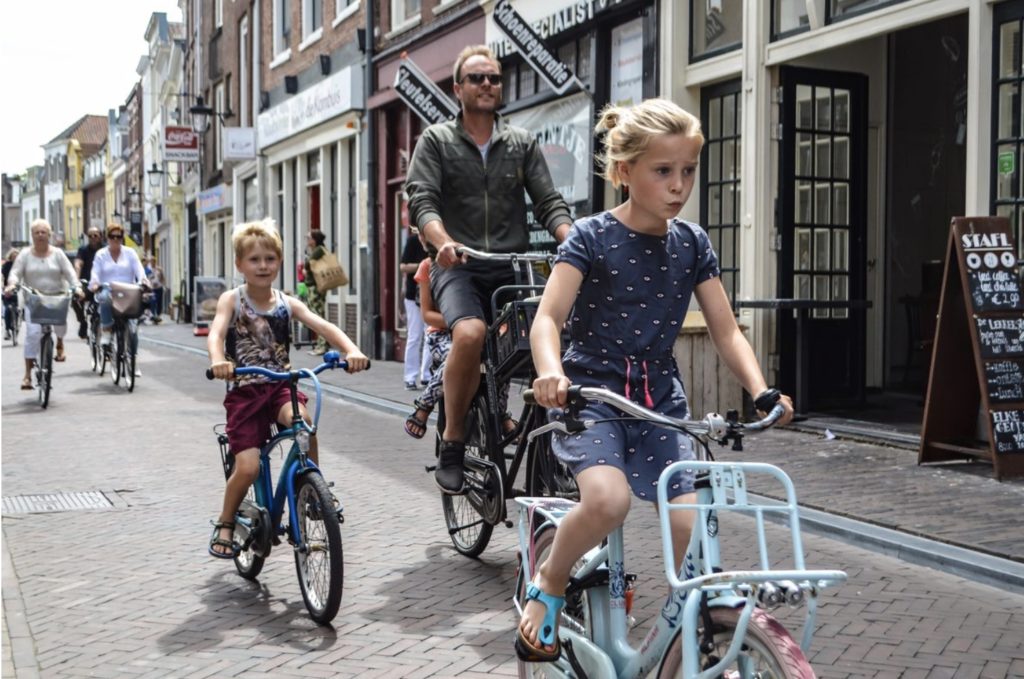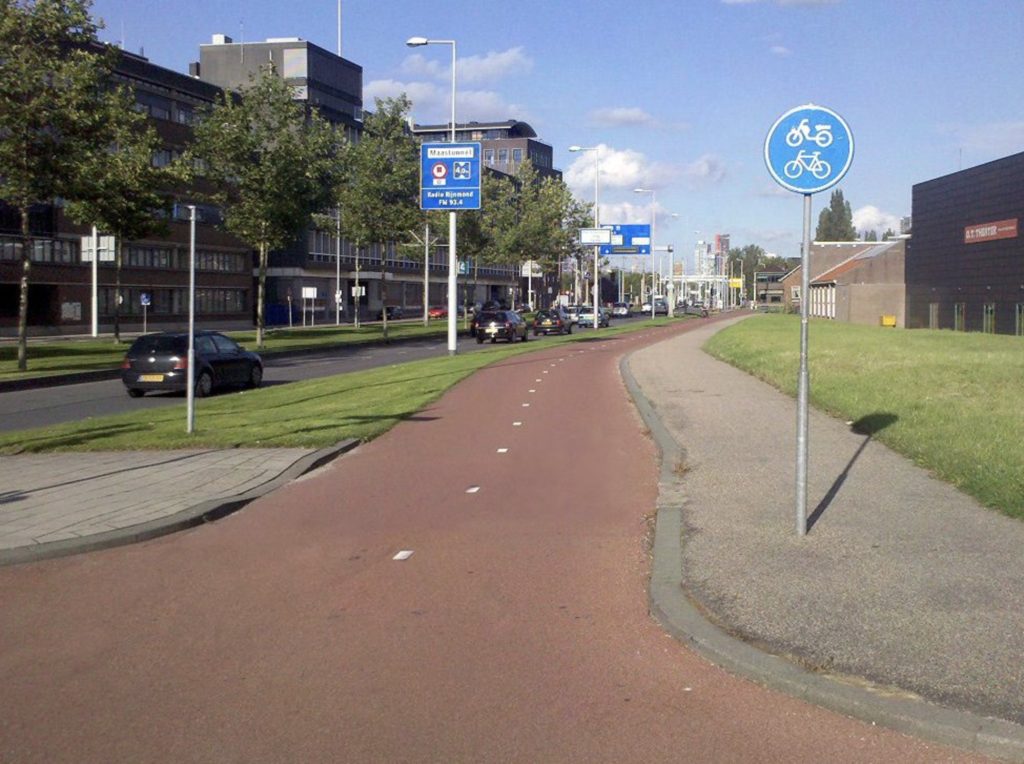By Rick Bernardi
Years ago, I was commuting to work one morning, riding from downtown San Jose to Almaden Valley in south San Jose, when I had my first-ever bicycle crash. I was on a downhill stretch approaching the final leg of my commute when an insect flew into one of the front vents of my helmet. Attempting to get the insect out of my helmet, I shook my head. That was my downfall. While I was preoccupied with shaking the insect out, I didn’t notice my wheel drifting towards the curb. When my wheel brushed against the curb I went down, rolling through a roadside right-of-way littered with a “cyclist-friendly” mix of gravel, broken glass, and bullhead thorns.
When I finally came to a stop, I lay in the gravel for a minute or two, not wanting to move. But eventually, I roused myself, got up, and after plucking a multitude of bullhead thorns out of my flesh, and inspecting my fresh road rash, I got back on my bike and continued my ride to work.
Weeks, or maybe even months later, I noticed one day that the plastic shell on my helmet was cracked. I had no idea how it had cracked, but after trying to remember any impacts the helmet might have received, the crash came to mind. Was that when my helmet had cracked? It was the only explanation I could come up with, but I hadn’t noticed any impact to my head when I crashed.
“Maybe,” I thought, “my helmet had done its job.”
Maybe.
I continued to ride with that helmet, until years later, when I learned that it’s imperative to replace a helmet after an impact to the helmet from a crash. While I couldn’t be 100% certain that there had been an impact to my helmet during my crash, I couldn’t be certain that it hadn’t been impacted either. And so, erring on the side of caution, I replaced my old helmet with a new helmet. One benefit, beyond the certainty that I was now riding with a helmet that hadn’t impacted with the ground, was that my new helmet beat my old helmet hands down on style points.
And one feature of my new helmet was a must-have for me—it came with insect netting across the vents.
***
Jose Alzorriz was a stickler for bike safety. Several of his friends had been injured while riding, so Alzorriz was the one who would remind his friends to wear a helmet, stay in the bike lane, and obey the law. Alzorriz not only talked the talk, he also walked the walk—he always wore his helmet while riding. And when he found out that his girlfriend and her daughter didn’t own bicycle helmets, “He bought us helmets right away,” his girlfriend recalled, “and said, ‘You’re biking in the city. That’s atrocious. You need to protect yourself.’”

On August 11, 2019, Alzorriz pulled up to a Brooklyn intersection and stopped at the red light. Just as he came to a stop, a speeding car in the oncoming traffic lane blew through the red light and broadsided a van. The van careened into Alzorriz, striking him and pinning him underneath the van when it finally came to a rest. Bystanders attempted to lift the van off Alzorriz, but despite his helmet, he suffered severe head injuries and died at the scene.
Lest anyone think it unusual that a cyclist wearing a helmet could nevertheless suffer fatal injuries in a crash, consider the following fatalities:
- Brett Jarolimek, 31, was wearing his helmet when he was run over by a right-turning garbage truck in Portland, Oregon on October 22, 2007. Jarolimek died at the scene.
- David Meek, 51, was wearing his helmet when he was clipped by a truck that passed too close in Chattanooga, Tennessee on March 5, 2009. Meek was dragged under the rear tires of the truck and died at the scene.
- Amelie LeMoullac, 24, was wearing her helmet when she was run over by a right-turning truck in San Francisco, California on August 14, 2013. LeMoullac died at the scene.
- Milt Olin, 65, was wearing his helmet when he was rear-ended by a distracted driver in Los Angeles, California on December 8, 2013. Olin suffered severe blunt-force trauma injuries on impact and died at the scene.
***
When I had a solo crash, I was wearing my helmet, and it may have absorbed a glancing-blow impact that maybe happened. I’m still not sure, but it’s the only way I can explain a crack I later found in the plastic outer shell of my helmet. On the other hand, I wouldn’t have crashed at all if I had not been wearing a helmet.
Jose Alzorriz, Brett Jarolimek, David Meek, Amelie LeMoullac, Milt Olin, and countless other cyclists who were killed in motor-vehicle collisions were also wearing helmets, and their helmets did not prevent the fatal injuries they suffered.
This is to be expected.
The general public consensus is that bicycle helmets save lives, and are so necessary that cyclists who ride without a helmet have come to be viewed as negligent, and risking their lives. This belief is so ingrained that people feel comfortable freely shouting unsolicited “Wear a helmet!” advice to complete strangers passing on the street.
But the general public consensus about bicycle helmets is wrong. Cyclists can and do suffer serious, sometimes fatal injuries despite wearing a helmet. There are three main reasons this happens.
First, a bicycle helmet can do nothing to prevent injuries to the parts of the body that are not covered by the helmet. When Milt Olin was rear-ended by a distracted driver, his body hit the windshield at 48 miles per hour. Even if the helmet had been able to protect his head at that speed (and in fact, it couldn’t), there was nothing his helmet could have done to protect his body from the force of that impact.
Second, bicycle helmets are not designed to protect the cyclist from the force of motor vehicle-speed impacts. Bicycle helmets are only designed to withstand the impact of a low speed 14 MPH fall from a height of between 1 and two meters—the kind of fall a cyclist would have falling off a bike in a low-speed solo crash. When Jose Alzorriz was hit by an out of control van, the force of the impact far exceeded the design parameters of his helmet, and he succumbed to severe head injuries despite his helmet.
Third, bicycle helmets are not designed to prevent concussions, and there are arguments that bicycle helmets may even convert direct impacts to rotational impacts, potentially making injuries worse.
These facts are virtually unheard of by the general public. It’s extremely common, for example, to read media reports indicating whether a cyclist who has been injured or killed in a car-on-bike collision was wearing a helmet. This might make sense to the media reporting this detail, it might make sense to the law enforcement officers releasing this detail, and it might make sense to the general public reading this detail. But few, if any people reporting this information and reading this information will question whether the cyclist’s helmet or lack of helmet made any difference in the outcome of the collision.
If the cyclist was not wearing a helmet, and suffered injury to the torso, did the lack of a helmet have any bearing on the cyclist’s injuries? If the cyclist was not wearing a helmet, and suffered an impact to the head that was well beyond the design parameters of a helmet, did the lack of a helmet have any bearing on the cyclist’s injuries? These questions never arise in media reports, because the general public’s belief is that helmets prevent injuries. This belief also surfaces in courtrooms, where the lack of a helmet will often be used to paint a cyclist as “negligent,” even though it’s the driver’s negligence that caused the cyclist’s injuries.
This belief in the ability of bicycle helmets to protect cyclists in situations far beyond what a helmet could possibly do is not founded in reality. It’s a magical belief, and is the basis for some cyclists referring to bicycle helmets as “Magic Styrofoam Hats.”
This magical belief in bicycle helmets is not just a naïve but well-meaning hope. It’s a necessity for shifting the blame from negligent drivers to the cyclists they injure and kill—which is exactly what happens when a driver hits a cyclist who was not wearing a helmet. Rather than ask why the driver crashed into the cyclist, people ask why the cyclist wasn’t wearing a helmet. Rather than hold the driver accountable for negligence, people blame the cyclist for not wearing a helmet. Rather than protecting cyclists with cyclist-friendly laws and infrastructure, people propose mandatory helmet laws that do nothing to address the dangers cyclists face.
So are helmets just a distraction then, providing no real benefit to cyclists? Should cyclists just stop wearing helmets?
It depends on how you look at it.
Many cyclists swear by their helmets. And there’s evidence that helmets do lessen injuries.
But there are also helmet detractors among the ranks of cyclists, and they have evidence to support their position too.
I always wear my helmet when I ride. I’ve hit my head on the pavement twice. Hard. Not while riding, fortunately, but it’s still world-jarring, and if you’ve never done it, you don’t want to.
Ever.
Trust me on this.
Having hit my own head hard on the pavement, I’d rather have that inch of Styrofoam between my head and the pavement if there is a “next time” (hopefully not!), even if the helmet isn’t guaranteed to prevent an injury.
But I’ve also ridden my bike helmet-free. There’s a carefree sense of freedom and joy that comes from riding your bike, the road opening up before you, the wind in your hair. I get it. And by its very nature, armoring-up detracts from some of that carefree joie de vivre that we experience on a bike. Cycling is a very safe activity (and safer by far than the known health risks of a sedentary lifestyle); the most serious hazards we face come from car-on-bike collisions, and unfortunately, bicycle helmets are not designed to reduce the risk of car-on-bike collisions, or to prevent the injuries caused by car-on-bike collisions (but here’s what does help you avoid car-on-bike collisions). In fact, there’s evidence that drivers take even more risks with the lives of helmeted cyclists than with non-helmeted cyclists. This evidence suggests that drivers view bicycle helmets as devices that are capable of mitigating the driver’s own carelessness.
So when we surrender the carefree joy of riding a bike to the fear of riding with the wind in our hair, we are succumbing to a false belief that the helmet can protect us from our worst fear, and that is simply not possible. It’s the kind of magical thinking that the general public—motorists law enforcement, the media, legislators, and our legal system—place in the “Magic Styrofoam Hats.”
So although I wear a helmet when I ride, I’m under no illusions about what a helmet can do for me. I know that my helmet is designed to absorb the impact in a low-speed fall from my bike, and may reduce the severity of injuries at somewhat higher speeds. But at best, in a car-on-bike collision, I can only hope that it’s better than nothing.
I can hope.
And here’s the thing—what I’ve found in my experience is that when I ride with a helmet, it feels dangerous to ride without one. And when I ride without a helmet, after I get over my initial unease, it doesn’t feel dangerous at all. In other words, “safety” and “fear” are sometimes subjective feelings, rather than objective experiences of what’s actually happening around us.

Fear. And Hope. They work together to convince us that a bicycle helmet has magical properties that somehow transcend its real-world limitations. Yes, I could have a solo fall, but it’s so rare an occurrence that it’s not really worth worrying about, beyond regularly making sure my mechanicals are in good condition. And yes, I could get hit by a car, but that, too, is a relatively rare occurrence, and a helmet is unlikely to be of much help in any but the gentlest of car-on-bike collisions.
And yet I wear a helmet when I ride.
Which brings us back to the question: Should cyclists wear a helmet, on the theory that it’s better to have whatever protection a helmet can offer, than to have no protection at all? Or should cyclists stop relying on Magic Styrofoam Hats to protect them from careless and dangerous drivers?
I’ve already made my choice evident. But I won’t presume to answer that question for you. That is a question that rightly should be left to the individual cyclist. There are arguments for helmets, and arguments against helmets, and cyclists should do their own research and draw their own conclusions.
That said, it’s important to remember the limitations of bicycle helmets, for two very important policy reasons. First, mandatory helmet laws are a misguided effort that purport to protect cyclists but actually do little to address the real issues cyclists face. We know what the problems are and we know what the solutions to those problems are, and bicycle helmets are not the answer. In fact, British Cycling policy advisor Chris Boardman has said that “I think the helmet issue is a massive red herring. It’s not even in the top 10 of things you need to do to keep cycling safe or more widely, save the most lives.”
Second, bicycle helmets serve as a very convenient mechanism for shifting the blame for cyclists’ injuries away from negligent drivers, and placing that blame on the injured cyclists themselves. To see how misguided this blame-shifting is, consider what would happen if a negligent driver hit a pedestrian in the crosswalk, and then at trial blamed the pedestrian for not wearing a helmet. Or consider what would happen if a negligent driver crashed into and injured another driver, and then at trial blamed the injured driver for not wearing a helmet.
These hypothetical blame-shifting attempts appear ludicrous, because they are. But when the negligent driver’s victim is a cyclist, this courtroom blame-shifting not only does happen, it seems “normal.” Cyclists do need protection from negligent drivers, but that needed protection comes in the form of better infrastructure, better laws, and better enforcement, not styrofoam “armor.”

If You’ve Been Injured By A Careless Driver
If you do happen to get hit by a careless driver, contact bicyclelaw.com or another personal injury attorney who understands bicycling. While many attorneys are competent to handle general injury cases, make sure your attorney has experience and is familiar with:
- Bicycle traffic laws
- Negotiating bicycle accident cases with insurance companies
- Trying bicycle accident cases in court
- The prevailing prejudice against cyclists by motorists and juries
- The names and functions of all bicycle components
- The speed bikes travel as well as braking and cornering
- Bicycle handling skills, techniques, and customs
- How to get the full replacement value property damage estimates for your bicycle
- Establishing the value of lost riding time
- Leading bicycle accident reconstruction experts
- Licensed forensic bicycle engineers
- Establishing the value of permanent diminished riding ability
For more information
- For information about arguments and studies supportive of helmet effectiveness, see Bicycle Helmet Safety Institute
- For information about arguments and studies skeptical of helmet effectiveness, see Bicycle Helmet Research Foundation
- Related Article: Cyclists Are Dying In Traffic. Will Mandatory Helmet Laws Save Them From The Drivers Who Are Taking Their Lives? Part 1
- Related Article: Cyclists Are Dying In Traffic. Will Mandatory Helmet Laws Save Them From The Drivers Who Are Taking Their Lives? Part 2
- Related Article: Cyclists Are Dying In Traffic. Will Mandatory Helmet Laws Save Them From The Drivers Who Are Taking Their Lives? Part 3
- For more information about bicycle helmet laws in Oregon, see Oregon Bicycle Helmet Law
- For information about bicycle helmet laws in every state, see Bicycle Helmet Laws
- For information about bicycle accidents, see About Bicycle Accidents
- For information about protecting yourself with insurance, see Insurance Advice
- For more in-depth information about accidents and insurance, see Bicycling & the Law
- For information on avoiding accidents before they occur, see How to Avoid Car-On-Bike Accidents
If you have been injured in a bicycle accident, whether in a solo accident that may be the result of another party’s negligence, or in a collision with another person, contact bicyclelaw.com for a free consultation with bicycle attorney Bob Mionske.
